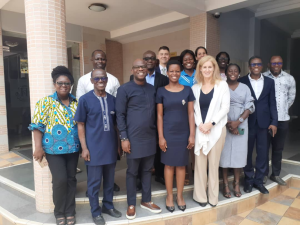Join a powerful, unprecedented alliance for better eye health for all.
Join IAPB-
Choose an alternate language here
Shaping Ghana’s eye care landscape – the journey of collaboration
Amidst the difficulties in Ghana, this initiative sets an inspiring example of eye care advocacy. Adopting the public-private partnership approach, they used evidence though a survey to bolster their advocacy efforts such as reducing the prices of Glaucoma medications. Despite the challenges, an impact was made, and it becomes an inspiring story of success. It is also an instance of making this sustainable through a network of stakeholders. This instance exemplifies some of the key aspects of successful advocacy from the “Advocacy for Eye Health: A Beginner’s Guide” such as use of scientific evidence to bolster credibility, inclusiveness, and enhancing the project’s resilience.
In 2020 in Ghana, their crude prevalence of blindness was estimated to be 0.32% according to VLEG.1 . There was a dearth of critical evidence that can inform advocacy priorities and a need emerged to conduct a population-based national survey. A well planned and executed public private advocacy model resulted in compelling evidence for the government to take action However, the budget to conduct such a survey was beyond the reach of only one organization.
The global eye health action plan 2014–2019 aimed to reduce avoidable visual impairment as a global public health problem and to secure access to rehabilitation services for the visually impaired. The 3 objectives recommended are:
To generate evidence, we set out to conduct a national blindness and visual impairment survey to know where we are with several years of investments and service provision.
We approached several partners but only one agreed to partner with us, despite the fact that each and everyone thought it was a brilliant idea and a very useful initiative. Then the third objective came to mind. “The multi-sectoral engagement and effective partnerships”. We decided to use the Public Private Partnership (PPP) approach which worked.

Our approach on the PPP model made government agencies, private sectors, non-governmental organizations our stakeholders in the project. In this mode of engagement, we worked with
1. Government agencies:
2. Private Sector
The Standard Chartered Bank through the Seeing is Believing project provided some financial support.
3. Non-Governmental Organizations
Swiss Red Cross and Operation Eyesight Universal also provided some funding as well.
The impact of this was phenomenal.
The results of the survey triggered these benefits. (See Table below)
| Results of the Survey | Advocacy outcome |
| Cataracts account for about 55% of the blind population in Ghana | Birth of National Cataract Outreach Program (NCOP) – Himalayan Cataract Project and other partners are supporting Cataract Surgery outreach around the country, helping to increase the CSR |
| Glaucoma accounts for 19.4% of the blind population | Advocacy to Govt for the reduction of the prices of Glaucoma medication in Ghana |
| Only 5% of people with refractive error actually have eyeglasses – translating to a backlog of about 7 million pairs of eyeglasses | Several NGOs with affordable glasses in Ghana now. Advocacy tool for National Health Insurance to include eyeglasses on the list of commodities |
Authored by Dr Boateng Wiafe, Technical Advisor, Operation Eyesight Universal
Our Advocacy to Action 2023 Regional sessions are opportunities for successes and lessons learnt to be shared more widely across the sector. The sessions also support and inform advocates with relevant tools and resources available from IAPB and global bodies. Advocacy for Eye Health- A Beginner’s Guide takes you through 5 essential steps to build an effective advocacy project along with how to make a powerful case on eye health. Refer to more such toolkits and resources in our Advocacy Hub.
Refer to Vision Atlas for more insights on regions and countries, which has a rich mix of the latest eye health data, narrative, and presentation tools. Our Knowledge Hub brings together evidence, information, key opinions, resources, guides, tools, and the sharing of member experiences on the most important topic areas in global eye health.